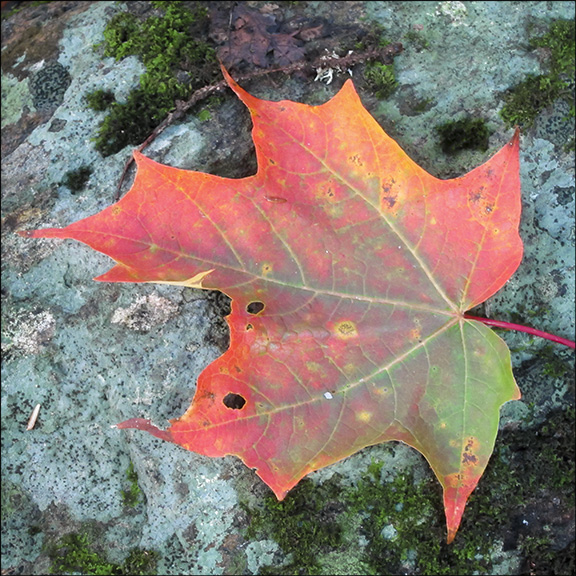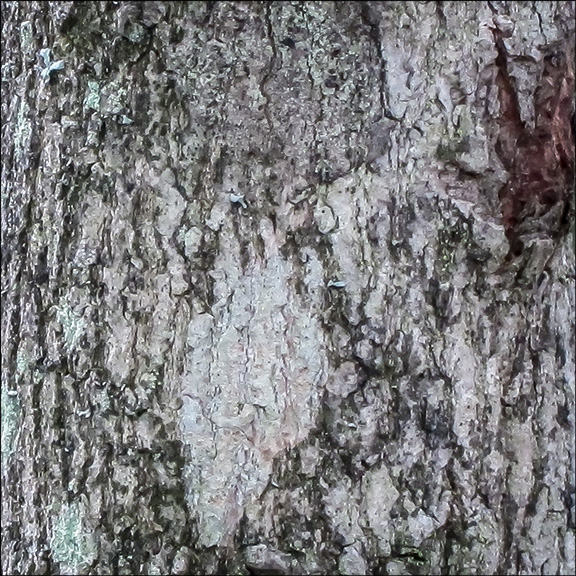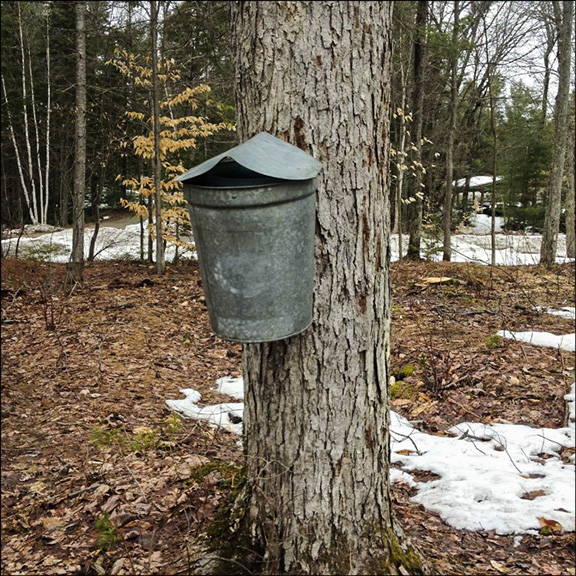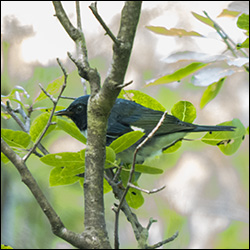Trees of the Adirondacks:
Sugar Maple (Acer saccharum)
 Trees of the Adirondacks: Sugar Maple leaves have five lobes. Sugar Maple leaf on the Barnum Brook Trail (28 July 2012)
Trees of the Adirondacks: Sugar Maple leaves have five lobes. Sugar Maple leaf on the Barnum Brook Trail (28 July 2012)
| This page is no longer being updated. For an updated and expanded version of this material, see: Sugar Maple (Acer saccharum). |
The Sugar Maple (Acer saccharum) is a large, deciduous tree which flourishes in well-drained soil in the Adirondack Mountains. It is a member of the Soapberry Family. The Sugar Maple is one of about twenty species in the genius Acer which occur in North America. Sugar Maples are also known as Hard Maple, Rock Maple, Head Maple, Sugartree, and Bird's-eye Maple. The Sugar Maple is the state tree of New York and the national tree of Canada, as represented by the maple leaf on its flag. It has a life span of 200-300 years.

Identification of the Sugar Maple: Like other maples, Sugar Maples have opposite, lobed leaves. The leaves of the Sugar Maple usually have five squarish, shallow lobes. Each of the largest three lobes has one to several sharp-pointed tips. There is a moderately deep U-shaped notch between the lobes. The upper surface is green in the summer; the lower surface is pale green to whitish. The leaves turn red, yellow, or orange in autumn, contributing to the brilliant palette of colors seen in September and early October in the Adirondacks.
Keys to identifying the Sugar Maple and differentiating it from other maples include its leaves, bark, growth habit and habitat.
- Both Sugar Maple and Red Maple leaves may have five lobes. However, the leaves of the Sugar Maple lack the irregularly and usually double-toothed margins of the Red Maple. Also, the dips between the lobes of the Sugar Maple are u-shaped, while the indentations between the lobes of the Red Maple are pointy, forming a sharp "v."
- The leaves of the Sugar Maple also differ from those of the Striped Maple (which are uniformly and finely double-toothed) and the Mountain Maple (which are coarsely toothed).
- The bark of the Sugar Maple is smooth and gray when the tree is young, becoming irregularly furrowed, scaly, and dark gray on older trees. Sugar Maple bark lacks the distinctive narrow, white vertical strips of the Striped Maple.
- The mature Sugar Maple is a large tree, growing 50-70 feet tall, with a straight, single trunk, many ascending branches, and a symmetrical oval head. This growth habit contrasts with that of the Striped Maple (which is a small tree or large shrub, often divided into several branches from near the base) and the Mountain Maple (which usually grows as a bushy shrub).
- Habitat is another clue distinguishing the Sugar Maple from the Red Maple. Red Maple trees are more tolerant of wet soil. A large, single-trunked maple tree growing near a marsh or other wetland is more likely to be a Red Maple.

The Sugar Maple flowers in mid- to late-spring, producing tiny greenish yellow flowers with five sepals. In the Adirondack Mountains, this tree usually flowers in May. The seeds are the familiar “helicopters.” The seeds are green, turning reddish tan; the seeds drop in late summer. The twigs of the Sugar Maple are glossy and reddish brown. The buds are brown and sharp; the buds are slender and pointed down.
Sugar Maples have been affected by climate change. The tree does not like the warmer temperatures and has already started to disappear in central and southern New York State. Some sources attribute the declining vigor of Sugar Maples in some areas to acid rain.
Historical Uses of the Sugar Maple: The Sugar Maple was the premier source of sweetener, along with honey, for both Native Americans and early European settlers. Native American tribes – including the Algonquin, Cherokee, Dakota, and Iroquois – used maple sap to make syrup and sugar. The Micmac also used the bark to make a beverage. The Ojibwa allowed the sap to sour to make vinegar, which was mixed with maple sugar to cook sweet and sour meat. The Potawatomi used maple sugar instead of salt to season all cooking. Cherokee used the wood for lumber and to make furniture. The Malecite used the wood to make paddles, torch handles, and oars. The Ojibwa used the wood to make bowls and other cooking tools. .
Native American tribes also used the Sugar Maple for medicinal purposes. For example, the Iroquois used maple sap for sore eyes and a compound infusion of the bark as drops for blindness. It was also used as a blood purifier and dermatological aid. The Mohegans used the inner bark as a cough remedy.
Current Uses of the Sugar Maple: The Sugar Maple is currently one of the most valuable hardwood trees in the Northeast. Its wood has a wide variety of uses, including furniture, paneling, flooring, interior trim and veneer. Sugar Maple wood is also used for gun stocks, tool handles, plywood dies, cutting blocks, wooden ware, novelty products, sporting goods, bowling pins, and musical instruments. The wood is especially suited for bowling alleys. Some trees develop special grain patterns – including birdseye maple, with dots suggesting the eyes of birds, and curly and fiddleback maple, with wavy annual rings. Such variations in grain are highly prized in cabinet making. Wood from the Sugar Maple is also a very good fuel, giving off a lot of heat and forming very hot embers. The ashes of the wood are rich in alkali and yield large quantities of potash .

In addition, the Sugar Maple – with sap which has twice the sugar content of other maple species – is the mainstay of commercial syrup production. Production of maple syrup is a multi-million-dollar industry in the U.S. and Canada. Canada, primarily Quebec, produces over 70% of the world's maple syrup. The remainder is produced in the US, where maple syrup production in 2014 totaled 3.17 million gallons. The US value of production in 2013 was $132 million. Vermont is the largest US maple producer, producing 42% in 2014. New York State is the second largest producer, with 17%. New York State currently taps less than 1% of the state's nearly 300 million maple trees.
Sugaring season begins in early spring, starting in February or early March in downstate regions. Nights below freezing and days at higher than 5°C are needed to ensure good sap flow. Each tree yields between 5 and 60 gallons of sap, depending on the health of the tree and the weather.
- Early in the spring, when the maple trees are still dormant, temperatures rise above freezing during the day. As a result, positive pressure develops in the tree, causing the sap to flow out of the tree through a half-inch wide tap hole which has been drilled about 4.5 feet above the ground.
- When the temperature drops back below freezing at night, suction develops, drawing water into the tree through the roots and replenishing the sap in the tree. This allows the sap to flow again during the next warm period.
- This cycle of warm and cool periods is essential for sap flow.
The maple sap is then boiled to produce maple syrup. Fresh sap flowing out of the maple tree usually contains around 2% sugar. Finished maple syrup is 66-67% sugar. To create maple syrup from maple sap, it is necessary to increase the sugar concentration of sap. Many gallons of water need to be removed. Usually, about 40 gallons of sap are required to produce one gallon of finished syrup, depending on the sugar content of the sap, which in turn depends on the health and age of the tree and the time of the season.

Wildlife Value of the Sugar Maple: Sugar Maple is a food source for several wildlife species. White-tailed deer, moose, and snowshoe hares commonly browse on Sugar Maple trees. Red squirrels feed on its seeds, buds, twigs, and leaves. Porcupines eat the bark and can girdle the upper stem. The flowers appear to be wind-pollinated, but the early-produced pollen is important for Apis mellifera (honeybees) and other insects. In addition, the Sugar Maple is a caterpillar host for the Cecropia Silkmoth and the Rosy Maple Moth.
A number of birds build nests in Sugar Maples, including American Redstarts, Evening Grosbeaks, Baltimore Orioles, and Northern Cardinals. Twigs from Sugar Maple trees are sometimes used by Chimney Swifts as nest-building material. For several species – including the Cerulean Warbler, Scarlet Tanager, Hairy Woodpecker, and Summer Tanager – the Sugar Maple is one of the preferred trees for foraging for insects.
Bird species which breed in the Northern Hardwood Forest and mixed hardwood/conifer forests associated with Sugar Maples include:
| Ruby-throated Hummingbird | Veery |
| Mourning Warbler | Black-throated Blue Warbler |
| Hooded Warbler | Least Flycatcher |
| Northern Parula | Acadian Flycatcher |
| Brown Creeper | Red-eyed Vireo |

Distribution of the Sugar Maple: Sugar Maples are widespread and abundant in the eastern and mid-western United States, into southern Canada. Sugar Maple are found throughout New English, New York, Pennsylvania, and the mid-Atlantic states. This species grows from Nova Scotia and New Brunswick westward to Ontario and Manitoba, North Dakota and South Dakota, southward into eastern Kansas into Oklahoma, and southward in the east through New England to Georgia.
The Sugar Maple grows in a wide variety of soils, but does best on deep, well-drained soils. It is rarely found in swamps.
The Sugar Maple – growing in abundance with Yellow Birch, Eastern Hemlock, American Beech, and Eastern White Pine – is an indicator species for the Northern Hardwood Forest. Sugar Maple are also common in mixed hardwood-conifer forests. The under-story in this habitat is often dominated by Striped Maple and Hobblebush. Herbaceous species which thrive here include Painted Trillium, Goldthread, Common Wood Sorrel, Carolina Spring Beauty, Pink Lady's Slipper, and Wild Sarsaparilla.
Sugar Maples at the Paul Smiths VIC: Sugar Maples grow widely on the VIC property in hardwood and mixed hardwood-conifer forests and can be found along parts of virtually all the trails. However, because this tree does not tolerate wet soils, it is not found in the VIC's wetland areas, such as Heron Marsh and Barnum Bog. The Sugar Maple is one of the eleven tree species marked with signage along the Barnum Brook Trail, providing a convenient way to learn to differentiate this species from the other maples, which are also identified on the trail.

VIC Sugar Maples are also the key component of the VIC's Maple Sugaring Program – part of a larger effort to increase local maple syrup production in New York State as a path to sustainable economic development. As part of the program, the VIC developed two demonstration sugar bushes – one with lines and one with buckets – to model what a family could do in their own back yard. The sugar bushes are located near the intersection of the Skidder Trail and the Easy Street Trail. The tubing is on the left hand side of the Skidder Trail (proceeding west); the buckets are concentrated on the other side of the Skidder Trail. The buckets are also dispersed in places where there are groups of suitable maples. Sugaring season in our part of the Adirondack Mountains usually lasts around five or six weeks, beginning as the weather warms in March.
The sap collected from the Sugar Maples is transported to the VIC Sugar House for processing. The VIC's maple sugaring operation uses a wood-fired evaporator to remove the water from sap to produce syrup. The wood used to fuel the evaporator is harvested by students and staff from the VIC property and stored behind the sugar house. The VIC has developed interpretive signage for the Sugar House to help visitors understand and appreciate sugar making. Maple products produced in the VIC Sugar House are sold at the VIC store.
References
- United States Department of Agriculture. Forest Service. Silvics of North America. Sugar Maple. Retrieved 19 January 2015.
- United States Department of Agriculture. Plants Database. Retrieved 19 January 2015.
- United States Department of Agriculture. National Agricultural Statistics Service. Maple Syrup Production. 11 June 2014. Retrieved 19 January 2015.
- Lady Bird Johnson Wildflower Center. Native Plant Database. Retrieved 19 January 2015.
- University of Wisconsin. Trees of Wisconsin. Acer saccharum. Retrieved 19 January 2015.
- Online Encyclopedia of Life. Acer saccharum. Retrieved 19 January 2015.
- University of Wisconsin. Robert W. Freckmann Herbarium. Retrieved 21 January 2015.
- New York Flora Association. New York Flora Atlas. Retrieved 21 January 2015.
- University of Michigan. Native American Ethnobotany. A Database of Foods, Drugs, Dyes and Fibers of Native American Peoples, Derived from Plants. Retrieved 21 January 2015..
- Plants for a Future. Database. Retrieved 21 January 2015.
- The Birds of North America. American Redstart, Evening Grosbeak, Chimney Swift, Baltimore Oriole, Northern Cardinal, Ruby-throated Hummingbird, Veery, Mourning Warbler, Black-throated Blue Warbler, Hooded Warbler, Least Flycatcher, Northern Parula, Acadian Flycatcher, Brown Creeper, Cerulean Warbler, Summer Tanager, Red-eyed Vireo, Scarlet Tanager, Hairy Woodpecker. Subscription Web Site. Retrieved 21 January 2015.
- Trees of the Northern Forest Trail Walk
- Paul Smith’s College VIC. Barnum Brook Tree Game.
- Michael Wojtech. Bark: A Field Guide to Trees of the Northeast (UPNE, 2011).
- George A. Petrides. A Field Guide to Eastern Trees (Boston: Houghton Mifflin Company, 1998), pp. 54-55, 206-207.
- George A. Petrides. A Field Guide to Trees and Shrubs (Boston: Houghton Mifflin Company, 1958,1972), pp. 6-7, 97-98, 120-121.
- John Kricher. A Field Guide to Eastern Forests. North America (Boston: Houghton Mifflin Company, 1998), pp. 61, 72-75, 126-127.
- Gil Nelson, Christopher J. Earle, and Richard Spellenberg. Trees of Eastern North America (Princeton : Princeton University Press), pp. 618-619.
- C. Frank Brockman. Trees of North America (New York: St. Martin's Press), pp. 210-211.
- Keith Rushforth and Charles Hollis. Field Guide to the Trees of North America (Washington, D.C., National Geographic, 2006), p. 201.
- National Audubon Society. Field Guide to North American Trees (New York: Alfred A. Knopf, 1980), Plates 258, 374, 592, pp. 379-380.
- Allen J. Coombes. Trees (New York: Dorling Kindersley, Inc., 1992), p. 101.
